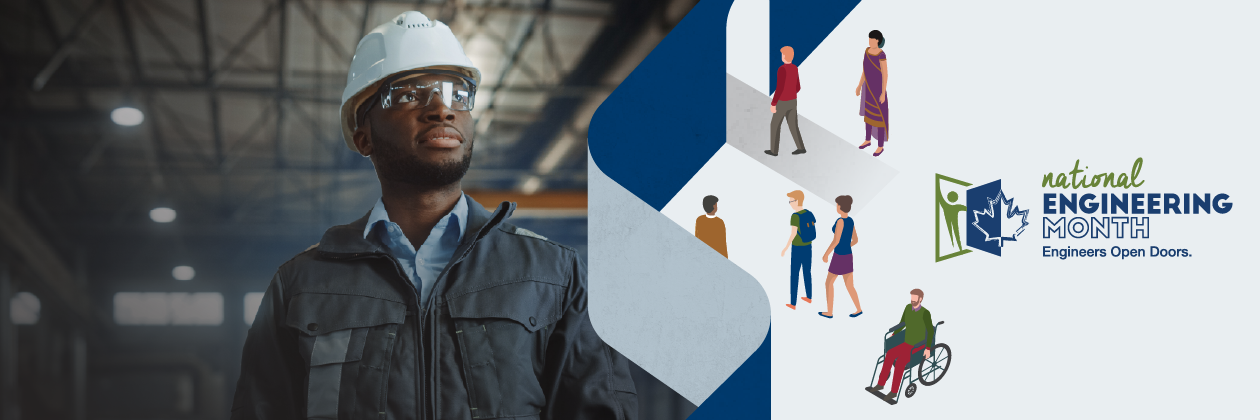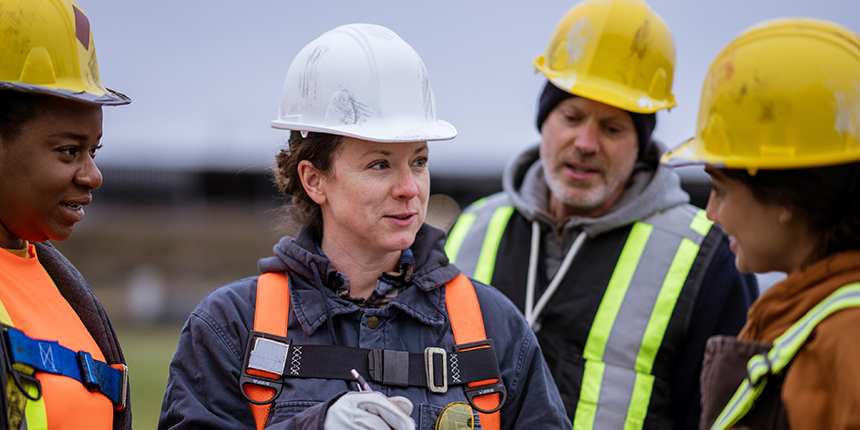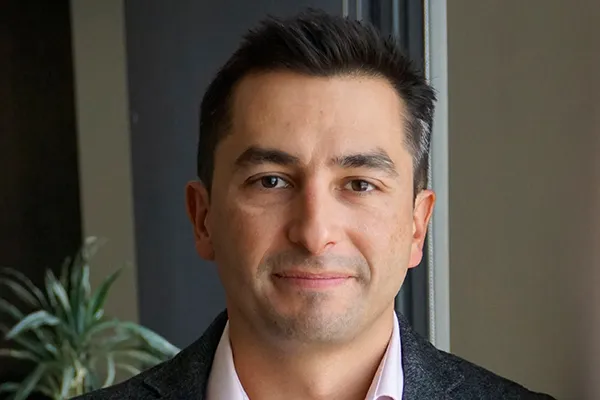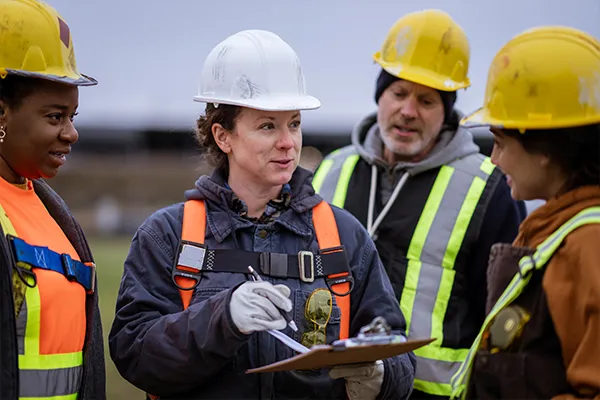

This year marks the 100th anniversary of the Calling of an Engineer, often known as the Obligation Ceremony, where engineering graduates receive their iron ring and make a commitment to ethical conduct.
The Obligation Ceremony and the iron ring are a key milestone on the journey to becoming a professional, licensed engineer. While an engineering education and the Obligation Ceremony first introduces ethical concepts, earning the professional licence—the P.Eng.—cements those ethical concepts into professional practice. Once licensed, engineers are further bound by the ethical code of the province or territory where they practise, and the licence demonstrates to employers, peers, and society, an engineer’s commitment to upholding the values and ethical standards of the profession.
How do engineers integrate this ethical commitment into their daily work? How do they meet the high standards set out in provincial or territorial codes of ethics and, even more importantly, do not only what is lawful, but what is right? It’s a high bar to clear, but the stakes are also high, since engineers are responsible for the creation and continued existence of myriad aspects of our built and natural environment.
Educating engineering students about ethics
Most of us have a basic understanding of ethics by the time we reach our teen years, but engineering students generally receive a formal introduction to ethical principles in the final year of their undergraduate degree. They learn the foundations of ethical philosophy, the codes of ethics they will be required to follow, and the legislation that governs engineers in the province or territory where they are studying.
Laurie Lockington-Wong, P.Eng., a lecturer and Engineering Ethics Coordinator at Western University’s Thompson Centre for Engineering Leadership and Innovation, says students in the upper years of their undergraduate degree are better equipped to absorb and apply the materials covered in an ethics course.
“Some of the ethical concepts and topics that we cover do take a more mature student. There's a nice interplay between their technical knowledge and the ethical aspects. We integrate professionalism in all class activities. Students are curious about how to navigate workplace ethics scenarios, cases in tort law and contract law. I invite them to shift their perspective from that of a consumer to that of a responsible designer and developer. Students learn that as engineers, their responsibility to the public is paramount.”
At Western, students examine several real-life engineering tragedies such as the Quebec Bridge, Boeing 737 MAX, and the OceanGate Titan, from an ethical standpoint: “They're not only looking at what the engineering failure was, but what leadership attributes were deficient that might have led to this tragedy,” Lockington-Wong says.
Students are also invited to analyze emerging technologies, such as autonomous ride-hailing vehicles, lab-grown meat, or CRISPR gene-editing technology, from a number of ethical angles.
“The big lesson for students? We may not yet have Canadian legislation that guides the safe development of a given technology, so as engineers, we need to anticipate and mitigate the risks to the public and the environment and ensure equity for all stakeholders. Students practise integrating the United Nations Sustainable Development Goals by examining how emerging technologies might be best positioned to address these goals,” says Lockington-Wong.
Learning on the job
Once in the workforce, engineering graduates and junior engineers can turn to more experienced engineers for guidance on ethical considerations. While ethical considerations may have become second nature for engineers further into their careers, they can play an important role in mentoring and supporting newer engineers learning how to apply ethics on the job.
“[Ethics] will come up in conversations with more junior engineers. A lot of it is second nature, because you're always dealing with clients and contracts, and even if you're not thinking of it in terms of ‘this is my ethical responsibility,’ it does come up,” says Adam Wallace, P.Eng., a geotechnical engineering consultant with Tetra Tech Arctic Engineering Group and Vice-President of Engineers Yukon.
“It's just instinct at this point in my career,” says Karen Savage, P.Eng., Principal Geotechnical Engineer with RAM Geotechnical Engineering, a former chair of Engineers and Geoscientists British Columbia’s Professional Practice Committee and previous member of the Canadian Engineering Qualifications Board. “In large part because of my volunteer work within my profession, I'm always thinking about protecting the safety and welfare of the public and the environment.”
Savage says casual conversations around the filing cabinet are great opportunities to create teaching moments for newer engineers. Wallace agrees: “It's important to support them and be around for them to talk to, and try to build stronger, more ethical, more responsible engineers to pass the torch to.”
Practising engineering ethically
There are many ways engineers can approach their work with an ethics mindset. They should know their regulator’s code of ethics, of course. And all engineers-in-training must pass the National Professional Practice Exam that includes questions about ethics.
But what does it look like to practise engineering ethically? Savage and Wallace say it includes asking for peer review of your work; pushing back with clients who want to cut corners; speaking up when you see a problem or risk that isn’t being addressed; and escalating an issue if it’s not fixed the first time you raise it.
Savage notes that the Engineers Canada code of ethics recently added a clause that originated with the BC regulator that creates a duty to report any illegal, dangerous, or unethical engineering decisions or practices by registrants or others to the provincial or territorial regulator.
“If there's an issue on site during construction, you would report it to the safety officer and the general contractor. If it's in design, you would report it to the coordinating registered professional consultant, which is usually the architect. And if it wasn't resolved, then you would report it to the client. If a site situation wasn't resolved, you might need to escalate it to WorkSafe or to the authority having jurisdiction, and then to the regulator and/or other appropriate agencies. If it's something that needs to be pursued, then you do. You should.”
An engineer might also get involved in a project because they see potential risks and understand the ethical implications of not remediating them. Savage once responded to a request for proposals for design and construction of a new building at an outdoor education centre in North Vancouver, simply because she had spent time at the site as a parent volunteer and knew there were unaddressed flood and earthquake risks.
“It was in the floodplain of the Squamish River, and everybody thought the site was protected by berms, but they had just been pushed into place. They weren't designed at all, and they'd actually failed during a weather event. As well, upstream there was a dam operated by BC Hydro as a power-generating facility. They would sometimes dump a lot of water to create better safety for the reservoir, but there was a really faulty mechanism to advise downstream residents.”
Ultimately, Savage won the work and was able to bring on a geomorphologist, who helped her design the building to effectively mitigate both the flood and earthquake risks.
Savage also suggests engineers seek support from a provincial or territorial regulator if they have ethical concerns about a situation and aren’t sure how to proceed. Earlier in her career, she was examining a home whose foundations were being pulled apart and eventually determined that the home was built on a sloping field of debris material that had flowed down a nearby mountainside during a major weather event.
“It was a much bigger problem than I had the capacity and the wisdom to know how to address. So I contacted the director of professional practice at our provincial regulator. I'm not sure that is something all registrants know that they can do. I think we ultimately did something that was appropriate.”
Wallace says one of the toughest ethical situations for an engineer to deal with is admitting when you’ve made a mistake.
“You have to go to your client and say ‘yes, sorry, we screwed up and we want to fix it, and here's what it's going to take to fix it.’ Just take a deep breath and rip the band-aid off and get it over with.”
It’s something Wallace has had to deal with in his career, when an important change to a project’s design was not incorporated throughout a set of multi-disciplinary engineering drawings. And while he says it wound up costing both his firm and the client money, the relationship ultimately recovered because of his honesty: “Difficult times wound up turning into an overall positive experience for me.”
Why ethics matter
When it comes to ethics in engineering, Wallace says it’s essential to help clients understand the distinction between doing what’s simply legal and what’s right. Indeed, it’s a key part of the ethical commitment of a professional engineer.
“We have our duty to give our client our best, most educated, most professional opinion on what they need to do. And then sometimes you have to talk them into actually doing it, because they might not want to. You do have to sometimes stand your ground and make a decision. And the more you spend time in the game, the less uncomfortable that gets.”
More in this series

Kristen Facciol built her love of robotics into a career with the Canadian Space Agency

Canadian Engineering Grand Challenges: How Engineers Can Support Sustainable Development Goals

Amaury Camarena is using engineering to protect and preserve Canada’s coastal regions

